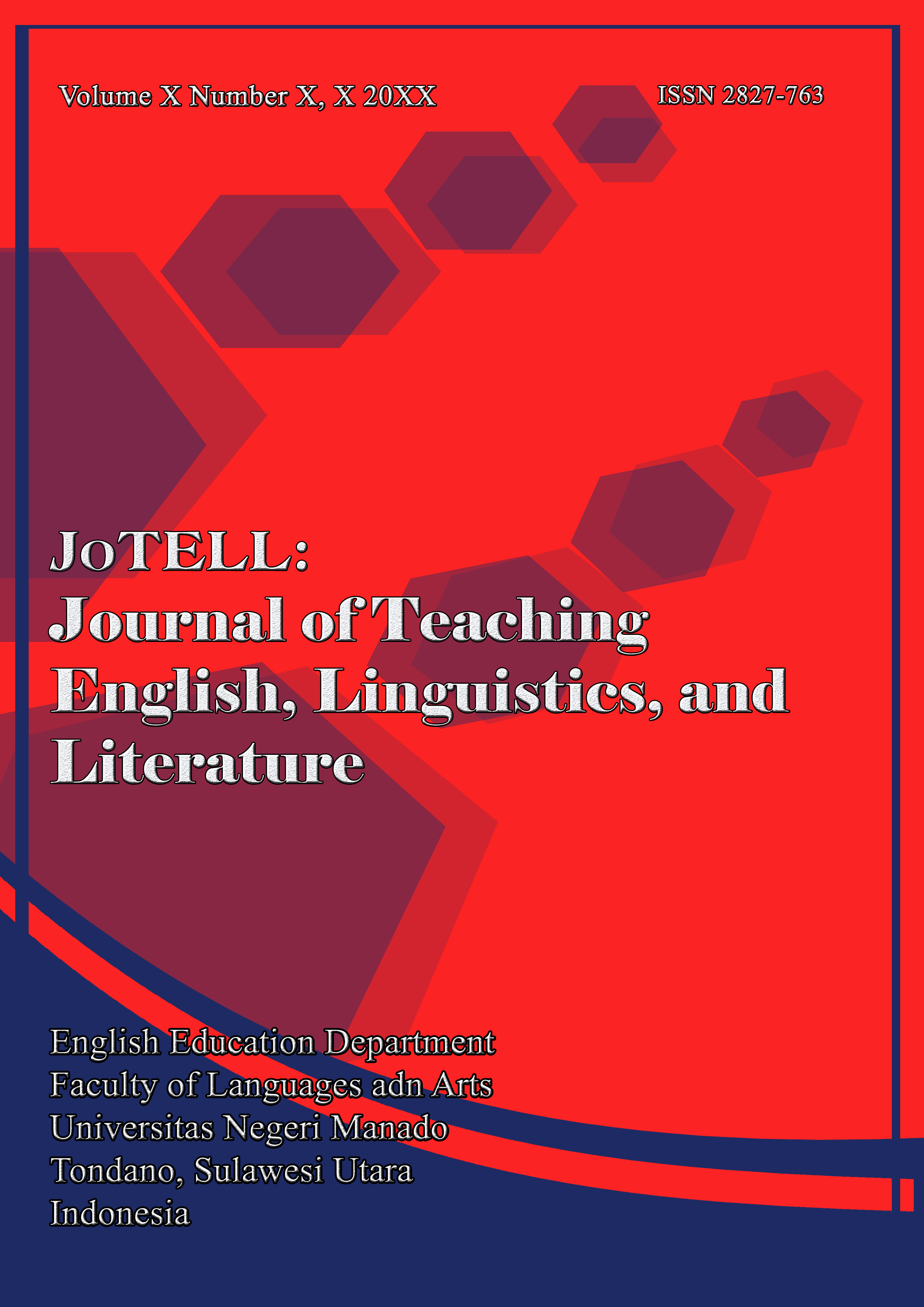INCREASING STUDENTS’ VOCABULARY BY USING PICTURES AT SMP KRISTEN 17 TATENGESAN
DOI:
https://doi.org/10.36582/jotell.v2i8.7194Abstract
The purpose of this study was to examine whether the use of pictures could increase students' vocabulary. Students of SMP Kristen 17 Tatengesan for the 2022/2023 school year (including 20 students of seventh grade) were selected for this study. Pre-experimental design with one group pre-test and post-test was used in this research. This study consisted in four meetings. Prior to treatment (used pictures), the first researchers performed a pretest. After treatment (used picture), students were given a post-test. Data collection technique used test as instrument. That is objective in terms of matching the item 5 numbers, completion 5 numbers and true/false 10 numbers, The total is 20 numbers. The result of this study found that pictures was effective showed the scores post-test (78.52) was higher those of pre-test (50.5). This suggests that the use of pictures is considered can effectively increase students vocabulary.ÂÂ
References
Chomsky, N. (1992). Speech at Conference on ‘Creation and Culture’. Barcelona Spain.
Hamalik, O. (1993). Media Pendidikan Cetakan ke VI. Bandung: Citra Aditya.
Hatch, E. And Farhady, H. (1982). Research design and statistics for Applied Linguistics. Cambridge: Newbury House Publisher
Hornby, A. S. (2006). Oxford Advanced Learners’ Dictionary. Oxford New York: Oxford University Press.
Kumayas, T., & Lengkoan, F. (2023). The Challenges of Teaching Grammar at the University Level: Learning From the Experience of English Lecturer. Journal of English Culture, Language, Literature and Education, 11(1), 98-105.
Lengkoan, F., & Olii, S. T. (2020). Self-Correction in Writing a Paragraph. Celt: A Journal of Culture, English Language Teaching & Literature, 20(2), 387-395.
Liando, N. V., Tatipang, D. P., & Lengkoan, F. (2022). A study of translanguaging practices in an EFL classroom in Indonesian context: A multilingual concept. Research and Innovation in Language Learning, 5(2), 167-185.
Liando, N. V. F., & Tatipang, D. P. (2022). English or Indonesian Language? Parents’ Perception Toward Children's Second Language Learning Context. Jurnal Lingua Idea, 13(1), 61-75.
Liando, N. V. F., Tatipang, D. P., & Wuntu, C. N. (2023). First Language Interfere in EFL Classes: Revealing Students’ Perspectives and Teachers’ Reasons in ELL. REiLA: Journal of Research and Innovation in Language, 5(1), 77-88.
Maru, Mister Gidion. (2021). The Integration of ICT in ELT Practices: The Study on Teachers' Perspective in New Normal Era. International Journal of Interactive Mobile Technologies (IJiM). Vol 15 No 22.
Maru, Mister Gidion. Ratu, Donal Matheos. Dukut, Ekawati Marhaenny. (2018). The Use of the T-Ex Approach in Indonesian EFL Essay Writing: Feedbacks and Knowledge Exploration. International Journal of Engineering & Technology. Vol 7, No 3.25: Special Issue 25
Maru, Mister Gidion et.all. (2021). The Internet Use for Autonomous Learning During COVID-19 Pandemic and its Hindrances. International Journal of Interactive Mobile Technologies (iJIM) Vol 15, No 18. PP.65-79
Maru, Mister Gidion, Nur, Sahril, Lengkoan, Fergina. (2020). Applying Video for Writing Descriptive Text in Senior High School in the Covid-19 Pandemic Transition. International Journal of Language Education (IJoLE). No 04, Vol 03.
Prayogo, J. A. (2022). English Language Teaching in Indonesia in the 21st Century: What Needs Reinconforcing and Enhancing for the Teachers. KnE Social Sciences, 12-22
Wardhaugh, R.(1997). A Journal of Research Language Studies. New York. Mc.Graw Hill.
Downloads
Published
How to Cite
Issue
Section
License
Copyright (c) 2023 JoTELL : Journal of Teaching English, Linguistics, and Literature

This work is licensed under a Creative Commons Attribution-ShareAlike 4.0 International License.












